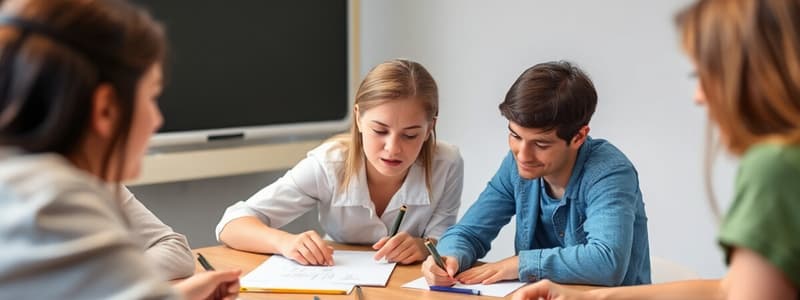Podcast
Questions and Answers
What is the primary role of a teacher in a Problem Based Learning (PBL) environment?
What is the primary role of a teacher in a Problem Based Learning (PBL) environment?
- To strictly dictate the curriculum content
- To act as a facilitator guiding the learning process (correct)
- To assess student performance continuously
- To provide direct instruction to students
Which of the following best describes the characteristics of a well-defined problem?
Which of the following best describes the characteristics of a well-defined problem?
- A complex issue with no clear end state
- A problem that requires subjective interpretation to resolve
- A clearly stated problem with specific goals and parameters (correct)
- A problem with multiple possible solutions and interpretations
In the context of learning, what does the SPICES model emphasize?
In the context of learning, what does the SPICES model emphasize?
- Integration of curriculum both horizontally and vertically (correct)
- Focused assessments on rote memorization
- Strict adherence to traditional teaching methods
- Prioritizing competitive environments among students
How does constructivism influence problem-solving in PBL?
How does constructivism influence problem-solving in PBL?
What challenge was identified regarding the curriculum at XYZ College?
What challenge was identified regarding the curriculum at XYZ College?
What is the main focus of problem-based learning compared to traditional learning?
What is the main focus of problem-based learning compared to traditional learning?
Which of the following is a characteristic of traditional medical curricula?
Which of the following is a characteristic of traditional medical curricula?
Which of the following best describes the role of the teacher in problem-based learning?
Which of the following best describes the role of the teacher in problem-based learning?
What is NOT an objective of the problem-based learning process?
What is NOT an objective of the problem-based learning process?
Which aspect of learning is emphasized by Bloom's taxonomy in problem-based learning?
Which aspect of learning is emphasized by Bloom's taxonomy in problem-based learning?
How does problem-based learning differ in the development of objectives compared to traditional learning?
How does problem-based learning differ in the development of objectives compared to traditional learning?
Which element is least associated with problem-based learning?
Which element is least associated with problem-based learning?
What is a key benefit of community-based education in the context of problem-based learning?
What is a key benefit of community-based education in the context of problem-based learning?
Flashcards
Problem-Based Learning (PBL)
Problem-Based Learning (PBL)
A learning method where students tackle real-world problems to develop knowledge and skills.
Constructivism
Constructivism
Learning is an active process of creating meaning from experiences, using prior knowledge.
Well-defined problem
Well-defined problem
A problem with a clear goal and a specific set of steps to solve it.
Ill-defined problem
Ill-defined problem
Signup and view all the flashcards
Problem
Problem
Signup and view all the flashcards
Integrated Curriculum
Integrated Curriculum
Signup and view all the flashcards
SPICES Curriculum
SPICES Curriculum
Signup and view all the flashcards
Traditional Learning vs. PBL
Traditional Learning vs. PBL
Signup and view all the flashcards
Higher Order Thinking
Higher Order Thinking
Signup and view all the flashcards
Objectives of PBL Process
Objectives of PBL Process
Signup and view all the flashcards
Process of Problem-Based Learning
Process of Problem-Based Learning
Signup and view all the flashcards
Small Groups in PBL
Small Groups in PBL
Signup and view all the flashcards
Study Notes
Problem Based Learning (PBL) Overview
- PBL is an evidence-based teaching and learning method.
- QHPE 601 course at Qatar University uses PBL.
- PBL focuses on using problems as a starting point for acquiring knowledge.
- PBL is an instructional strategy where students are given real-world contexts in complex situations, then work to resolve.
Objectives of PBL
- Describe PBL (Problem-Based Learning).
- Discuss the process of PBL.
- Identify roles and responsibilities in PBL.
- Reflect on the benefits and drawbacks of PBL.
Constructivism in PBL
- Active learning where prior knowledge (and experience) is crucial to building new frameworks of understanding.
- Learners are expected to activate prior knowledge and build upon existing concepts.
- Teachers are facilitators, guiding learners, not just 'lecturers.' Key concept from Merrill (1991).
Adult Learning in PBL
- Adults are self-directed learners.
- Adults value their learning experiences and use prior knowledge.
- They want learning to apply to their everyday lives.
- Adults are more interested in problem-based methods rather than subject-centred ones.
- They are more motivated by internal factors than external ones (Knowles, 1980, 1984).
Defining a Problem
- A problem involves a situation where a goal exists but a means to reach the goal is not immediately apparent.
- Problems can be defined in very specific (wel-defined) or general terms (ill-defined).
PBL - How it Works
- Small groups of students work together (typically <8) with a facilitator.
- Sessions typically meet around 2-3 hrs twice weekly.
- Learning starts with a problem or trigger based on complex situations.
- Information to solve the problem is not immediately presented—students are expected to identify what information they need
- Individual study allows learners to research solutions and gather data.
- Support materials (e.g., labs, lectures) are available for use.
- Learning is finalized through groups sharing their gathered information and knowledge.
- Specific roles like tutor, scribe, time keeper, chair are beneficial to the effective facilitation of group sessions using this method.
Traditional vs. Integrated Curriculum
- Traditional curriculum separated basic science knowledge and clinical expertise.
- An integrated curriculum introduces clinical knowledge earlier in the learning process, promoting quicker application of new knowledge and concepts.
- SPICES model is introduced as an approach of curricular integration.
PBL Case Studies
- Case studies (e.g., patient scenarios) form the basis of learning modules.
- Case Studies can include experimental data, photographs, videos, articles, simulated patients, etc
- Cases can be realistic, complex situations presented and used to trigger learning. The goal is to have students analyze the situation in groups, to identify needed information, and to work toward resolution.
Types of Learning Activities
- The activity format is shown as a drag-and-drop format.
- The activity uses visuals from slides 13-15.
- Traditional learning activities include being 'told what to know' and then memorizing, while PBL activities involve students identifying what they need to know.
- PBL students learn by applying knowledge from solving the assigned problems.
Higher Order Thinking
- PBL is intended to encourage higher-order thinking skills through applying, analyzing evaluating, and creating.
PBL Process–Seven Jumps
- PBL involves seven key steps, encompassing clarifying concepts, defining and analyzing problems, formulating learning objectives, self-study in groups, and sharing the newfound knowledge and understanding.
Assessing PBL Process
- Participation is a critical component.
- Preparation and interpersonal interaction skills need to be assessed during sessions.
- Contributions to the group process and critical thinking will help the facilitator to gauge learner understanding.
- Learning is successful if students can demonstrate self-directed problem solving.
Good PBL Facilitators
- A good facilitator fosters a safe, non-threatening learning environment.
- The facilitator encourages critical thinking and discussion among learners.
- They need to prompt learners, guiding their research of topics and ensuring discussion.
- They need to make clear evaluations of the group's and individual's learning performance.
- A commitment to student-centered learning is essential to the facilitator's role.
Good PBL Students
- Knowledge and presence in PBL sessions are extremely important.
- Self-directed learning demonstrates a commitment to the group and individual learning.
- Active participation in group discussions (positive contributions) are critical, as is a non-threatening environment that fosters constructive criticism.
- Willingness to evaluate self and peers constructively.
Benefits of PBL
- PBL fosters an enjoyable learning experience for students and educators.
- It also encourages self-directed learning and improves problem-solving and clinical reasoning skills.
- It also promotes deeper learning and collaboration.
- Retention of knowledge will be increased due to the application of knowledge to complex contexts and situations.
Case-based Learning (CBL)
- CBL uses problem-solving strategies in small groups.
- Students' advance preparation can also help learning in this method.
- Tutor plays an important role while working with the group.
- Cases (e.g., mini-cases, directed cases) are crucial for learning about issues in context.
Comparing PBL and CBL
- PBL is more student-centered and open inquiry.
- CBL is more facilitator-driven, more structured, and guided inquiry.
Note: More detailed information about specifics are included in the slides and are listed in these notes.
Studying That Suits You
Use AI to generate personalized quizzes and flashcards to suit your learning preferences.




